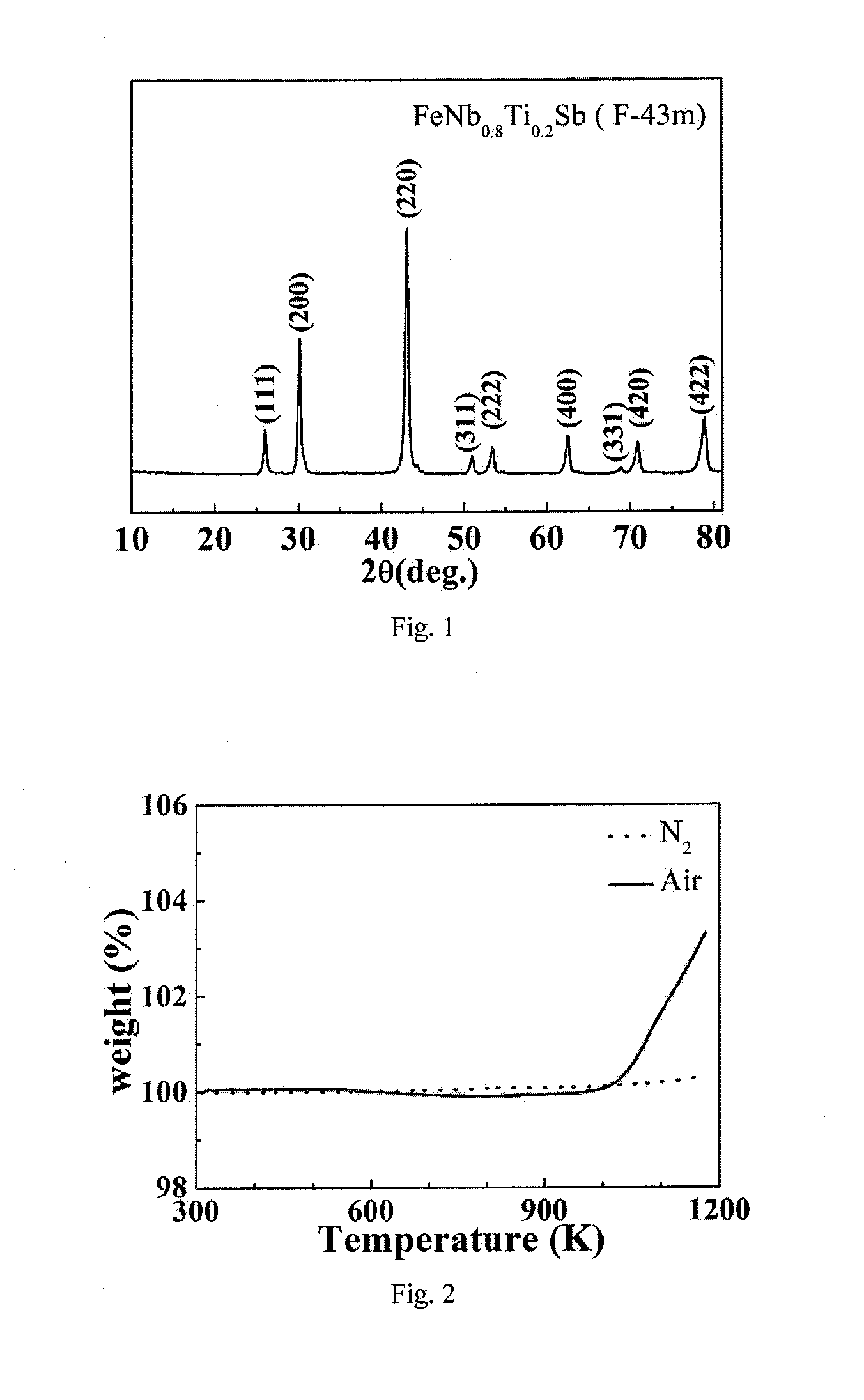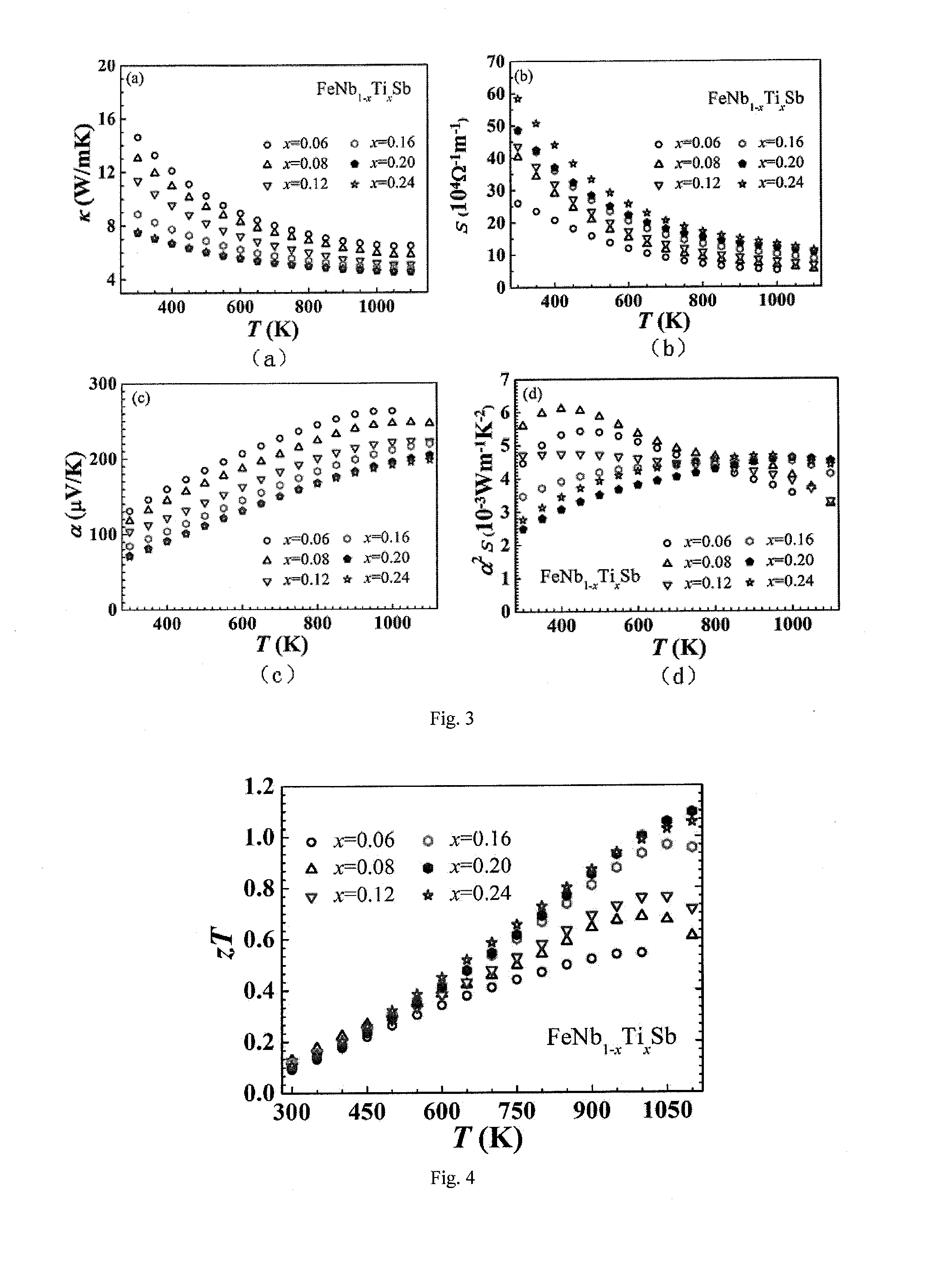A HIGH FIGURE OF MERIT P-TYPE FeNbTiSb THERMOELECTRIC MATERIAL AND THE PREPARATION METHOD THEREOF
a thermoelectric material and high figure technology, applied in the field of thermoelectric materials, can solve the problems of p-type half-heusler compounds with relatively poor thermoelectric performance, zt of 0.5, and corresponding p-type sige materials with relatively inferior thermoelectric performan
- Summary
- Abstract
- Description
- Claims
- Application Information
AI Technical Summary
Benefits of technology
Problems solved by technology
Method used
Image
Examples
embodiment 1
[0025]The ingot with nominal composition FeNb0.8Ti0.2Sb was prepared by levitation melting of stoichiometric amounts of Fe, Nb, Ti and Sb under an argon atmosphere. The ingot is melted three times to ensure homogeneity. The obtained ingot was mechanically milled to obtain submicron-scale powders. Then, the obtained powders were compacted by spark plasma sintering at 850° C. for 10 minutes under 65 MPa to obtain the final bulk material.
[0026]Phase structures of the sample was investigated by X-ray diffraction (XRD) on a RigakuD / MAX-2550PC diffractometer. The XRD pattern showed FeNbSb basic structure, a cubic structure (F43m), space group 216, as shown in FIG. 1.
[0027]The thermal diffusivity and specific heat of the sample were respectively measured by a laser flash method on a Netzsch LFA457 instrument and a Netzsch DSC-404 instrument. Then the thermal conductivity was calculated. The thermal conductivity k of the sample was 4.5 Wm−1K−1 at 1100K.
[0028]The Seebeck coefficient and elec...
embodiment 2
[0031]The ingot with nominal composition FeNb0.76Ti0.24Sb was prepared by levitation melting of stoichiometric amounts of Fe, Nb, Ti and Sb under an argon atmosphere. The ingot was melted three times to ensure homogeneity. The obtained ingot was mechanically milled to obtain submicron-scale powders. Then, the obtained powders were compacted by spark plasma sintering at 850° C. for 10 minutes under 65 MPa to obtain the final bulk material FeNb0.76Ti0.24Sb.
[0032]The thermal conductivity k of the sample FeNb0.76Ti0.24Sb 4.6 Wm−1K−1 at 1100K.
[0033]The Seebeck coefficient a and electrical conductivity s of the sample FeNb0.76Ti0.24Sb were measured on a commercial Linseis LSR-3 system, which were respectively 198 μV / K and 11.3×104 S / m at 1100K.
[0034]According to the above values and the formula zT=(a2sT / k), the zT value of the sample FeNb0.76Ti0.24Sb was 1.06 at 1100K.
embodiment 3
[0035]The ingot with nominal composition FeNb0.84Ti0.16Sb was prepared by levitation melting of stoichiometric amounts of Fe, Nb, Ti and Sb under an argon atmosphere. The ingot was melted three times to ensure homogeneity. The obtained ingot was mechanically milled to obtain submicron-scale powders. Then, the obtained powders were compacted by spark plasma sintering at 850° C. for 10 minutes under 65 MPa to obtain the final bulk material FeNb0.84Ti0.16Sb.
[0036]The thermal conductivity k of the sample FeNb0.84Ti0.16 was 4.8 Wm−1K−1 at 1100K.
[0037]The Seebeck coefficient a and electrical conductivity s of the sample FeNb0.84Ti0.16 were measured on a commercial Linseis LSR-3 system, which were respectively 219 μV / K and 8.6×104 S / m at 1100K.
[0038]According to the above values and the formula zT=(a2sT / k), the zT value of the sample
[0039]FeNb0.84Ti0.16 was 0.96 at 1100K.
PUM
 Login to View More
Login to View More Abstract
Description
Claims
Application Information
 Login to View More
Login to View More - R&D
- Intellectual Property
- Life Sciences
- Materials
- Tech Scout
- Unparalleled Data Quality
- Higher Quality Content
- 60% Fewer Hallucinations
Browse by: Latest US Patents, China's latest patents, Technical Efficacy Thesaurus, Application Domain, Technology Topic, Popular Technical Reports.
© 2025 PatSnap. All rights reserved.Legal|Privacy policy|Modern Slavery Act Transparency Statement|Sitemap|About US| Contact US: help@patsnap.com


